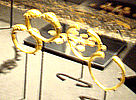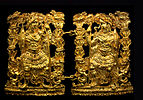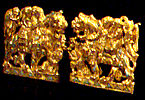Tillya Tepe
 Crown from Tomb VI (female owner) | |
| Alternative name | Tillya Tepe |
|---|---|
| Location | Afghanistan |
| Coordinates | 36°41′40″N 65°47′22″E / 36.69444°N 65.78944°E |
| Type | Burial ground |
Tillya tepe, Tillia tepe or Tillā tapa (
The hoard is a collection of about 20,600 ornaments, coins and other kinds of artifacts, made of gold, silver, ivory, etc., that were found in six burial mounds erected for five women and one man, with extremely rich jewelry, dated to around the 1st century BCE-1st century CE.
The heavily fortified town of
Dates and context

Several coins dated up to the early 1st century CE, with none dated later, suggest a 1st-century CE date for the burial. The coins found in the excavations belonged to
A silver coin was found in one of the tombs from the reigns of the Parthian king Mithridates II, who ruled c. 123–88 BCE. The coin was found in tomb III, and was apparently held in the hand of the buried woman.
An imitation gold coin of Parthian King Gotarzes I (95-90 BCE) was found in the left hand of the woman in tomb VI. The fact that this coin is in gold, and not silver or bronze as is usually the case for Parthian coinage, suggest that this imitation was made for prestige purposes. The coin is counterstamped with the frontal depiction of what might have been a local chieftain. The counterstamp was added so as to not damage the portrait of the Parthian king, perhaps indicating some degree of dependency on the Parthians.
A gold coin was also found in tomb III showing the bust in profile of the wreath-crowned Roman Emperor Tiberius. On the reverse is an enthroned, sumptuously draped female figure holding a spray and scepter. Coins of this type were minted in the city of Lugdunum in Gaul, between 16 and 21 CE.[4]
A Buddhist gold coin from India was also found in tomb IV (the male warrior). On the reverse it depicts a lion with a
Finally, a very worn coin has been identified as belonging to the Yuezhi chieftain Heraios, or Sapadbizes (20 BCE - 20 CE).[2]
It is thought that the site most likely belonged to the
Cultural influences
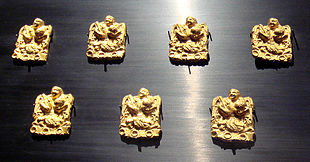
These pieces have much in common with the famous
A high cultural
The artifacts were also intermixed with items coming from much farther, such as a few Chinese artifacts (especially Chinese bronze mirrors) as well as a few Indian ones (decorated ivory plates). This seems to be a testimony to the richness of cultural influences in the area of Bactria at that time.
Loss and re-discovery
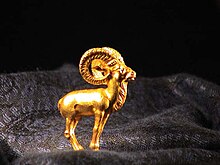
The hoard was thought to have been lost at some point in the 1990s, the National Museum of Afghanistan having been looted numerous times resulting in a loss of 70% of the 100,000 objects on display.[11] In 2003, however, it was found in secret vaults under the central bank building in Kabul.
In 1989 following a committee decision, the last Communist president of Afghanistan,
In 2003, after the Taliban was deposed, the new government wanted to open the vault, but the keyholders (called "tawadars") could not be summoned because their names were purposefully unknown. Hamid Karzai had to issue a decree authorizing the attorney general to go ahead with safecracking. But in time, the five key-holders were successfully assembled and the vault opened. Since then, the National Geographic Society has catalogued the collection, which appears to be complete – 22,000 objects. Also witnessing the re-opening were National Geographic Explorer and Archaeology Fellow Fredrik Hiebert and the archaeologist who originally found the hoard, Viktor Sarianidi.
Following an agreement between the Afghan government and
Exhibitions
Some of the most spectacular finds were a part of the traveling exhibition titled "Afghanistan: Hidden Treasures From the National Museum, Kabul" or "Afghanistan: Crossroads of the Ancient World" which were first on displayed in December 2006 in France’s
By 2020, the displays brought in over 350 million Afs ($4.5 million) for Afghanistan. In 2021, Mohammad Tahir Zuhair announced that the gold will be sent abroad for display and safekeeping.[19]
2021
In August 2021, the Taliban took control of Kabul, and the treasure is apparently missing yet again.[20]
Gallery
-
Eros. Tomb II, Tillia tepe.
-
Statuette of winged figurine
-
Cloth decorations.
-
Bracelets.
-
Decorative stars. Tomb I.
-
Amorini riding on fish, Tillia tepe. Tomb II.
-
Rings from Tillia tepe; the left one represents a seated Athena. Tomb II.
-
Necklace. Tomb II.
-
"Kings with dragons". Tomb II.
-
Men in armor, in Greek fighting gear. Tomb III.
-
"Akinakes" polylobed decorated daggers. Tomb IV.
-
Dyonisos and Ariadneriding a lion. Tomb VI.
Notes

| Saka kurgans[21] | ||||||||||||||||||||||||||
|---|---|---|---|---|---|---|---|---|---|---|---|---|---|---|---|---|---|---|---|---|---|---|---|---|---|---|
|
||||||||||||||||||||||||||
- ISBN 9789004154513.
- ^ S2CID 192970421.
- ^ ISBN 978-90-474-2049-1.
- ^ Sarianidi, Victor. 1985. The Golden Hoard of Bactria: From the Tillya-tepe Excavations in Northern Afghanistan. Harry N. Abrams, New York.
- ^ a b c Miyaji, Akira. "Miscellanies about the Buddha Image": 25–26.
{{cite journal}}: Cite journal requires|journal=(help) - ISBN 978-1-83860-868-2.
- ^ "Il semble qu'on ait là la plus ancienne représentation du Buddha, selon une modalité qui n'est pas encore celle de l'iconograhie boudhique traditionnelle" (French): "It seems this might be the earliest representation of the Buddha, in a style which is not yet that of traditional Buddhist iconography", in Afghanistan, les trésors retouvés, p. 280.
- S2CID 192970421.
- JSTOR 24048280.
- ^ Pankova, Svetlana; Simpson, St John (1 January 2017). Scythians: warriors of ancient Siberia. British Museum. p. 66, Item 25.
These graves at Tillya Tepe were initially regarded by the excavator as belonging to Yuezhi or Kushan nobility, but they are most likely to be tombs of a local tribal chief and his family who had strong connections with the Sakā cultures of Central Asia.
- ^ a b Lawson, Alastair (1 March 2011). "Afghan gold: How the country's heritage was saved". BBC. Retrieved 1 March 2011.
- ^ Fredrik Hiebert and Pierre Cambon, eds. Afghanistan: Hidden Treasures from the National Museum, Kabul. Washington DC: National Geographic, 2007.
- ^ "Afghanistan :: 2011-11-12". collections.smvk.se. Retrieved 2021-09-12.
- )
- ^ "Afghanistan: Treasures from the National Museum, Kabul|The Palace Museum".
- ^ "Hidden Treasures from the National Museum, Kabul".
- ^ Afghanistan: Hidden Treasures from the National Museum, Kabul (2008), pp. 18-19.
- ^ "news.gov.hk - Afghan treasures to be exhibited".
- ^ "Bactrian Gold Sent Abroad for Display, Safekeeping". TOLOnews. Retrieved 2021-02-06.
- ^ "Taliban announce hunt for ancient treasure". 23 September 2021. Retrieved 2021-10-02.
- .
References
- Sarianidi, V. I. "The Treasure of Golden Hill." American Journal of Archaeology, Vol. 84, No. 2 (Apr., 1980), pp. 125–131."The Treasure of Golden Hill", JSTOR
- Sarianidi, Victor. 1990–1992. "Tilya Tepe: The Burial of a Noble Warrior." PERSICA XIV, 1990–1992, pp. 103–130.
- "Afghanistan, les trésors retrouvés", Musée des arts asiatiques Guimet, ISBN 2-7118-5293-8
- Afghanistan: Hidden Treasures from the National Museum, Kabul (2008). Eds., Friedrik Hiebert and Pierre Cambon. National Geographic, Washington, D.C. ISBN 978-1-4262-0374-9.
- "L'Or De La Bactriane Fouilles De La Necropole De Tillia-Tepe." En Afghanistan Septentrional, Leningrad, Editions d'art Aurora, 1985
Further reading
| History of Afghanistan | |
|---|---|
 | |
| Timeline | |
| 410–557 | |
| Nezak Huns | 484–711 |
External links
- A photograph of the Tillya Tepe burial ground
- "An overview of the burials at Tillya tepe", Sara Peterson, 2018, from Academia.edu
- Afghanistan: Hidden Treasures from the National Museum, National Gallery of Art, Washington, DC
- Website dedicated to Afghanistan's Treasures by Musée Guimet (Paris, France): Afghanistan, les trésors retrouvés
- "Afghanistan: Nation Protects Storied Bactrian Treasure", from Radio Free Europe, June 9, 2006 – provides an overview.
- "Afghan golden treasure on display", from BBC News South Asia, December 6, 2006
- "Lost Treasures of Afghanistan Revealed ", from National Geographic, November 17, 2004
- "Parthian Aspects of Objects from Grave IV, Tillya Tepe", Sara Peterson, 2011 - 2012, from Academia.edu







